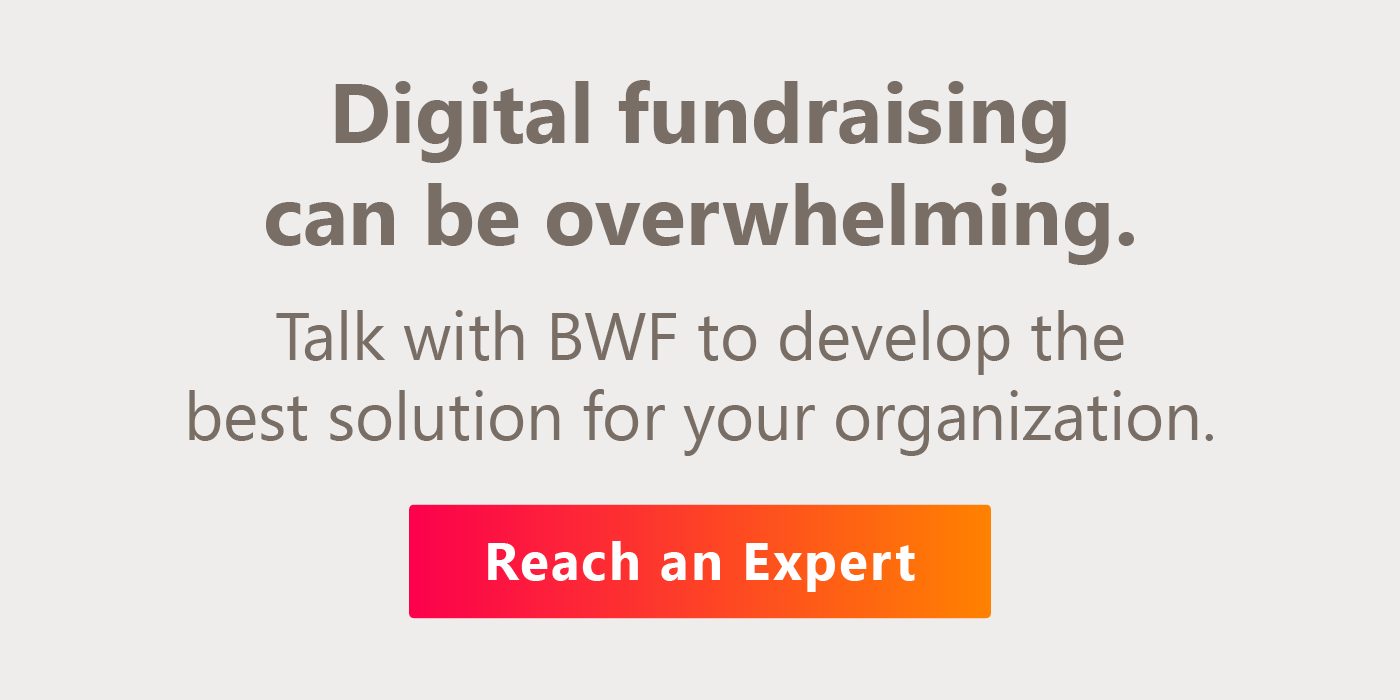Digital fundraising has transformed the way that nonprofits, universities, and other organizations raise money. Now, around 12% of total nonprofit revenue comes from online sources, representing an essential segment of charitable giving.
However, the online world is a noisy and crowded space, with plenty of other organizations competing for attention. How can you revitalize your digital fundraising approach to stand out and leave a strong impression on your audience?
This guide explores the ins and outs of digital fundraising and strategies to enhance your efforts. We’ll cover:
- The Benefits of Creating a Digital Fundraising Strategy
- Digital Fundraising Campaign Ideas
- Rising Digital Fundraising Trends to Know
- Digital Fundraising Best Practices
- Examples of Successful Online Fundraising Campaigns
Because of the multichannel nature of digital fundraising, having a clear plan in place to create a unified, compelling fundraising message across platforms is critical. Let’s start by exploring more benefits of an online fundraising strategy.
The Benefits of Creating a Digital Fundraising Strategy
To create a digital fundraising strategy, your fundraising team needs to discuss your priorities, assess your fundraising tools, and develop a unified game plan.
Although your digital strategy involves a lot of work upfront, this planning will be worth it in the end because of the multiple benefits that creating a digital fundraising strategy can bring to your organization, allowing you to:
- Create an ongoing revenue stream. Providing donors with an easy and convenient online fundraising process allows your organization to accept donations 24/7. By offering supporters recurring giving opportunities such as monthly giving programs, you can develop a reliable, sustainable online revenue stream to support your organization year-round.
- Reach donors near and far. An effective digital fundraising strategy allows your organization to expand its reach and connect with online audience members from all over the world. This enables you to grow your donor pool and develop long-term relationships with more donors.
- Make the fundraising process easier for your team and your supporters. One of the greatest benefits of digital fundraising is its convenience for both your fundraising team and your organization’s supporters. Donors can easily interact with your organization and give using their mobile phones and other devices. Meanwhile, your fundraising team can use digital tools to organize campaigns and events, track supporter information, and assess fundraising metrics.
- Strategize for future growth. Having an ambitious, well-organized digital fundraising strategy allows your organization to plan out its fundraising efforts well in advance. You can create campaigns that build on one another and use your fundraising metrics to determine where you’re succeeding and where there’s room for improvement. These activities allow you to chart a path to expand your fundraising capacity year after year.
Your organization might be testing the waters of online fundraising, launching a handful of campaigns throughout the year (like your annual giving campaign), and using a few online communication platforms to get the word out. With a unified digital fundraising strategy, you can approach these online fundraising initiatives much more intentionally, setting your organization up for long-term success.
Digital Fundraising Campaign Ideas
As you develop your digital fundraising strategy, you’ll need to choose a few different types of online fundraising campaigns to fill your calendar. Your digital fundraising campaigns should span multiple platforms to connect with a broader audience and reach different generations of donors.
Let’s review a few different types of effective digital campaigns:
Mobile fundraising campaign
Mobile phones are becoming one of the most important platforms for engaging with donors online, with 57% of nonprofit website traffic coming from mobile devices.
Specifically, a text-to-give campaign can be a great way to engage supporters via their mobile devices. Here’s how these campaigns work:
- You sign up with a text-to-give provider.
- You choose a keyword and receive a dedicated phone number.
- Supporters text the keyword to your phone number and receive a link to your online donation form.
Text-to-give campaigns are useful when paired with giving day events or other urgent fundraising initiatives because they allow supporters to give on the spot.
Remember, it’s important to mobile-optimize your online donation page before launching a text-to-give campaign. Edit the form in the mobile view and test the form using a smartphone. This ensures that participants won’t have to pinch or scroll around too much to fill out the form.
Promote your text-to-give number and keyword using your website, social media posts, and email newsletters to generate audience engagement.
Crowdfunding campaign
Crowdfunding involves creating and sharing a fundraising campaign page with a wide range of donors to gather a large number of small donations. Individuals and organizations have used the most popular crowdfunding platform, GoFundMe, to raise $9 billion from more than 120 million donations.
Start crowdfunding by setting up a campaign page on your chosen crowdfunding platform. Then, to make your campaign more engaging, follow these best practices:
- Choose a program or project to direct your campaign funding. It’s helpful to keep your crowdfunding campaign’s purpose narrow and choose a single project to focus on. You can easily communicate donor impact by showing supporters how their campaign contributions allowed you to complete a single, mission-critical project.
- Choose engaging photos and videos to include on your campaign page. These visuals should showcase your organization’s mission in action.
- Include a compelling description. Explain why you’re raising funds and how you intend to use donations. You can also feature a brief story from a volunteer, staff member, or someone who has benefited from your organization’s services.
- Share your campaign page widely. Share the link to the page on your social media pages, website, and email platform. Encourage supporters to share the link to their personal social media pages after completing their donations. Ask them to share a quick blurb about what inspired them to give or what your organization means to them.
Set a hard end date for your crowdfunding campaign to inspire donors to give ASAP rather than procrastinate.
Social media campaign
While individuals of all generations use social media, it’s still primarily the realm of younger generations. Young people use social media to read the latest news, interact with friends, and engage with their favorite nonprofit organizations.
Let’s take a closer look at a few popular social media sites and ways you can use them to promote fundraising:
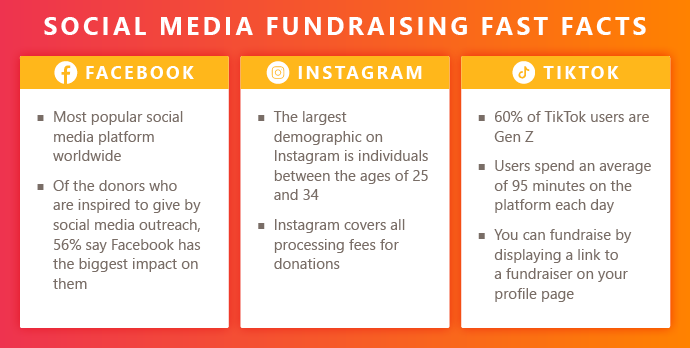
Facebook is the most popular social media platform worldwide, with almost 3 billion monthly users. Among the donors inspired to give by social media, 56% of them say Facebook has the biggest impact on their decision. Plus, the largest demographic on Facebook is men and women between the ages of 25 and 34. If your audience is made of younger Millennials, Facebook is a great platform to engage with them.
On Facebook, you can encourage your followers to start birthday fundraisers or general nonprofit fundraisers to raise money for your cause. Share information about the steps supporters can take to set up their own Facebook fundraisers. You can even provide a fundraising guide with photos, videos, and descriptions that supporters can personalize by adding details about their unique connection to your cause.
The largest demographic on Instagram is also individuals between the ages of 25 and 34. Similar to Facebook, your supporters can create their own Instagram fundraisers to support your cause. The fundraiser will live in their Instagram bio, and they can share the fundraiser in stories, posts, and live videos.
Instagram covers all processing fees for donations, meaning donors’ gifts will go directly toward your mission.
TikTok
60% of TikTok users are Gen Z, and users spend an average of 95 minutes on the platform each day, nearly twice as long as on Facebook and Instagram.
Some nonprofits can fundraise using Donation Stickers, which are added to live streams and videos and allow supporters to donate without leaving TikTok. If this feature isn’t available for your organization, any user can display a link to a fundraiser on their profile page.
To earn donations from TikTok, it’s important to actively grow your presence on the platform. Create a schedule for regular posting and interact with your followers by liking and responding to their comments. Participate in trends by using popular filters and sounds to make your videos more appealing to younger audiences.
No matter what type of social media campaign you choose to promote, support those who are fundraising on your behalf by sharing, commenting on, and liking their posts. Also, send each fundraiser a personalized thank-you direct message or email to emphasize how much their support means to your cause.
Online fundraising event
With the advent of virtual platforms like Zoom, Facebook Live, Instagram Live, and YouTube, it’s easier than ever for organizations to host online fundraising events.
A virtual event is a great way to kick off, wrap up, or generally support a major fundraising initiative, such as a Giving Day campaign or comprehensive campaign. With an online event, you can reach supporters near and far and allow them to tune in when it’s convenient for them.
Here are a few virtual event ideas that work great for fundraising in the digital realm:
- Gala or auction
- 5K or fun run
- Workshop or class
- Livestreamed concert or comedy show
- Online happy hour or networking event
To determine your virtual event type and theme, consider sending surveys to your supporters to get their feedback about the type of event they’d like to attend.
Promote your event across multiple platforms, including online and offline ones like direct mail. The more you can get the word out about your event, the more registrations you’ll have, and the more you can earn through event fundraising!
You might even consider creating a microsite for your event to give attendees everything they need to know to learn about the event and register in one place. A microsite is a single web page or cluster of pages focused on a narrow topic. Your microsite can highlight online event details, provide a countdown clock, and offer an easy way to register. Digital solutions providers like {{firstname}} can even help you create microsites that are personalized to your major donors’ interests.
Peer-to-peer fundraising
Peer-to-peer fundraising allows dedicated supporters to fundraise on behalf of your organization. This type of fundraising is similar to a social media campaign. However, in a peer-to-peer fundraising campaign, your supporters will create personalized fundraising pages and raise donations from their family members and friends.
Peer-to-peer fundraisers work because people tend to be more willing to donate to a cause they don’t know a lot about if they’re doing so to support someone they love. In fact, 39% of Americans say they’ve donated to a charity because of a request from a family member or friend.
You can make your peer-to-peer campaign more engaging by aligning it with a fundraising event, such as:
- A 5K or walk-a-thon
- A fitness challenge
- A Polar Plunge
For example, participants might collect pledges based on how many miles they’re able to walk in your walk-a-thon event and then collect donations after the event concludes.
Similar to a social media fundraiser, your peer-to-peer fundraising participants will have the greatest success if your organization supports them at every stage of the process. You can create a peer-to-peer fundraising guide with photos, videos, and statistics that supporters can include on their peer-to-peer fundraising page.
Also, be sure to share fundraising tips with your supporters, such as the best time of day to post on social media. Highlight studies from other organizations such as Sprout Social or Hubspot, or use your organization’s social media analytics to recommend the best time of day to receive high social media engagement.
Email campaign
Email remains an engaging platform for nonprofits to connect with supporters. The average open rate across all nonprofit email messaging was 22% in 2021, a 16% boost from the previous year.
An email campaign involves sending supporters a series of email messages that present a story and encourage them to donate. For example, perhaps your organization is raising money to break ground on a new accessible community playground. You can create an email campaign that tells the story of a child in your community who benefited from using another accessible playground that you built several years ago.
Make sure your emails include engaging photos and infographics that highlight why you’re fundraising and who will benefit from your project. You can also use A/B testing to assess the effectiveness of different email elements, such as your subject lines, CTAs, and images. In the testing process, only change one element at a time to have a clearer understanding of which changes made the biggest difference in audience engagement.
Merchandise fundraising
In a merchandise fundraising campaign, your organization will create branded merchandise, such as t-shirts, water bottles, or tote bags, and sell them to your supporters online.
Merchandise fundraising campaigns are effective for multiple reasons:
- They create an additional revenue stream for your organization to bring in funds.
- They provide a tangible product in exchange for donors’ support.
- When supporters wear or use your merchandise while out in public, they promote brand awareness and recognition for your organization.
This is another instance where you engage your supporters by allowing them to get involved. Ask them to send in original designs and allow your audience members to vote on their favorite choices on your website and social media pages.
Use a merchandise fundraising platform to keep your campaign organized and easily sell and ship your merchandise.
Matching gift drive
Corporate matching gifts are an effective, but often overlooked way to boost fundraising revenue. In matching gift programs, companies match donations that their employees make to eligible nonprofits. Many companies match at a 1:1 ratio, but some organizations will match at a 2:1, 3:1, and even 4:1 ratio.
According to Double the Donation’s matching gift statistics, an estimated $4-$7 billion in matching gifts goes unclaimed each year. That means money left on the table for the nonprofits and universities that are eligible for these funds.
Raise awareness about matching gifts among your audience by hosting a matching gift drive. This digital fundraising campaign is a targeted marketing effort involving platforms like your social media, email, and website blog. Use these channels to spread the word about matching gifts and encourage supporters to research their matching gift eligibility.
In addition, include a matching gift tool on your website that allows donors to investigate their eligibility and submit matching gift requests easily. When you use a tool that offers auto-submission, it makes the process even easier. All donors have to do is submit their company email, and the matching gift tool will automatically complete the match request on their behalf.
Google Ad campaign
Google Ads are the sponsored ads that appear at the top of search results pages. For example, here is a Google Ad for the ASPCA donation page that may appear when you search the term “animal rescue nonprofit:”

A Google Ad campaign is a targeted digital marketing idea that can bring awareness to your fundraising efforts. To launch an effective ad campaign, follow these steps:
- Select the right landing page. The landing page you choose to highlight in your Google Ads should be well-designed and relevant to your fundraising efforts. For example, you could spotlight your main donation page or an information page for your current campaign.
- Choose effective keywords to target with your ads. Your keywords should have a high search volume and be relevant to the content of your landing page. For instance, if you’re running a campaign to generate registrations for your virtual 5K, you could target keywords such as “fundraising 5K” or “5K for charity.”
- Make your ad copy engaging. Like the ASPCA example above, your Google Ads should use engaging calls to action that inspire potential donors to get involved. Compelling language like “Fight Animal Cruelty” and “Change An Animal’s Life” helps draw prospective donors in and encourages them to learn more.
If you’re fundraising for a nonprofit, you may also be eligible for the Google Ad Grant. This grant offers nonprofits $10,000 per month in free Google Ad spending. Using Google Ad Grant funding, you can target a wider range of keywords without having to worry about straining your marketing budget.
eCard campaign
eCards are digital greeting cards typically sent via email, social channels, or text. You can sell eCards through your organization’s website or offer them as a perk for donors.
Selling eCards is a great way to supplement your online fundraising efforts and spread awareness of your cause. Donors can personalize the cards with a short note and the recipient’s name, and share them with their family and friends. Plus, your nonprofit can design the cards with your logo, colors, and fonts, promoting brand recognition.
Here’s an example of a Valentine’s-themed eCard fundraising campaign from One Tail at a Time, an animal rescue organization:
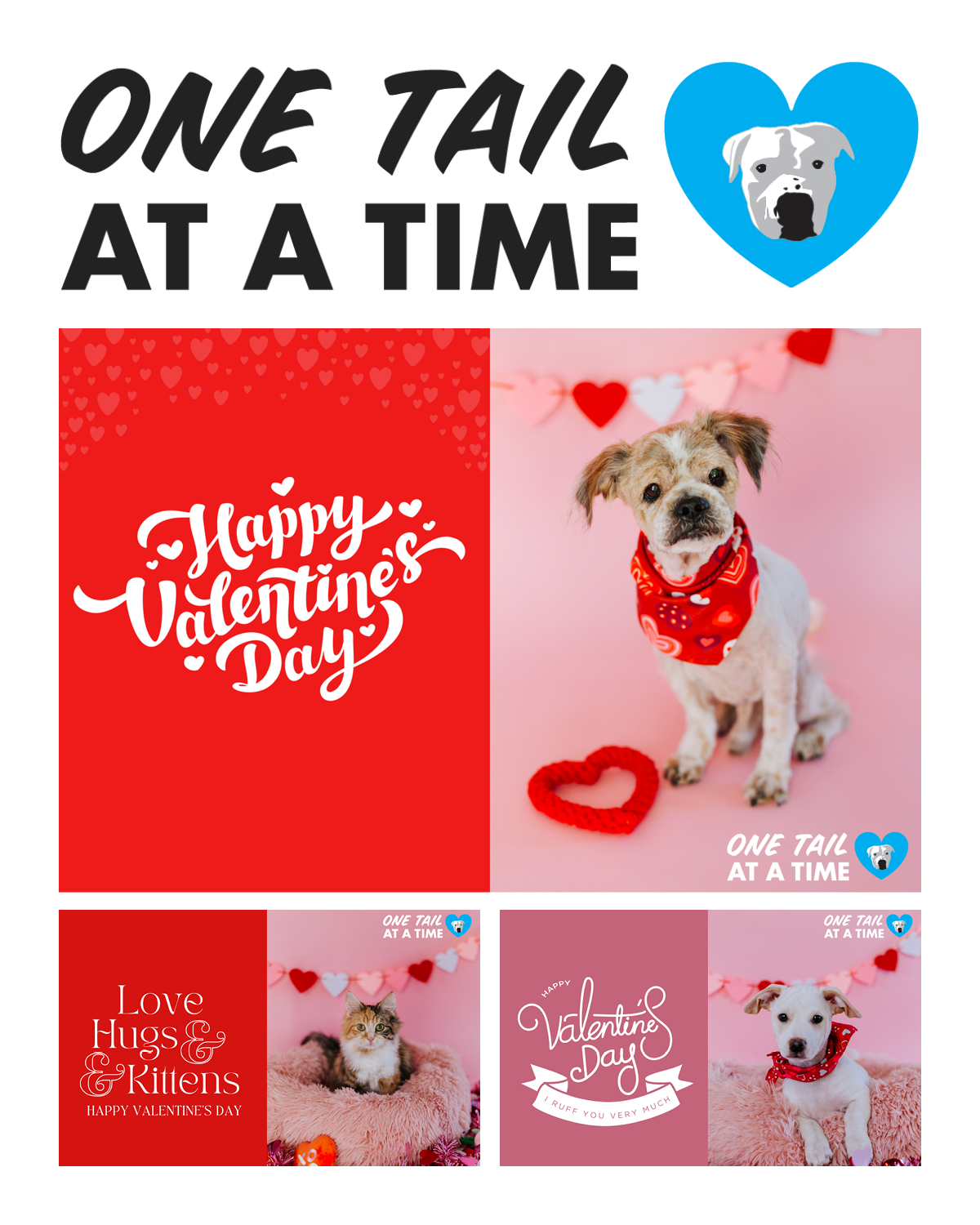
Use eye-catching imagery like the adorable kittens and puppies shown above to make your eCards appealing to donors.
Giving Day campaign
A Giving Day is a concentrated, time-bound campaign that usually lasts for just 24 hours. The most well-known giving day is #GivingTuesday, an international day of giving celebrated on the Tuesday after Thanksgiving in the United States.
Launching a GivingTuesday campaign is a great way to capitalize on the name recognition of this popular fundraising day. However, your organization can also host a separate Giving Day of its own to promote your mission with an urgent fundraising effort.
Boost engagement with your Giving Day campaign by taking these steps:
- Give your campaign a unique theme to help it stand out from your other fundraising efforts. For example, Tulane University’s Giving Day theme is “Give Green: A Day for the Audacious,” which inspires collective philanthropy among the Tulane community.
- Include a countdown clock on your website to display how much time is left until the campaign begins to get donors excited about getting involved.
- Share a fundraising thermometer on social media throughout the day that shows how much you have left to raise to reach your goal.
Host your campaign on a day that’s relevant to your organization’s mission to make it more memorable for supporters. For example, you could host it on the day your university was founded. Or, if your nonprofit helps fund breast cancer research, you could host your Giving Day in October, which is Breast Cancer Awareness Month.
Rising Digital Fundraising Trends to Know
Digital fundraising is constantly evolving, making it crucial for your organization to stay at the forefront of what’s new and innovative. For example, here are a few fundraising trends that have grown in importance over the past few years:
AI-driven fundraising campaigns
AI has rapidly evolved to become an essential tool for nonprofits to boost their fundraising and stay ahead of the curve. Organizations are using these tools for fundraising applications such as:
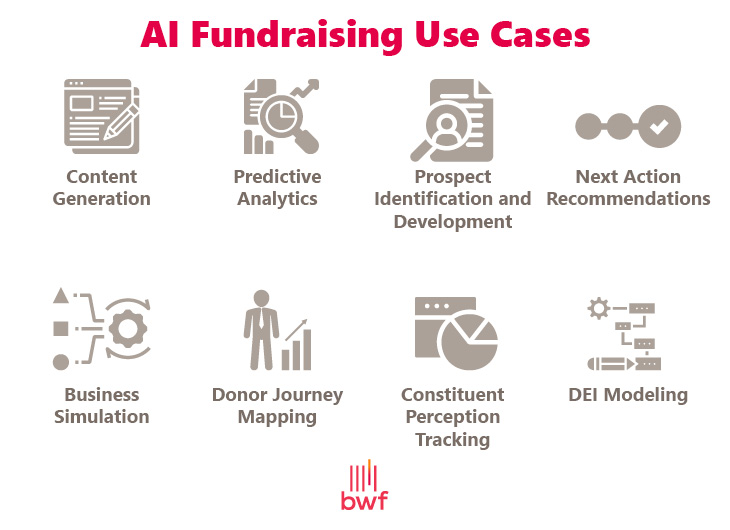
- Content generation
- Predictive analysis
- Prospect research
- Next action recommendations
- Business simulation
- Donor journey mapping
- Constituent perception tracking
- Diversity, equity, and inclusion (DEI) modeling
AI fundraising technology can be complex, so we recommend working with a data science expert (like BWF!) who can lead you through the process and ensure your AI strategies are both ethical and effective. For example, at BWF, we work with organizations to develop custom predictive models based on your unique dataset and goals, helping to increase return on investment (ROI) and target your unique audience.
Cryptocurrency and crypto donations
Cryptocurrency is a form of digital currency that is secured by cryptography, making it virtually impossible to counterfeit or double-spend. According to research from the Giving Block, the average crypto donor is a Millennial or Gen Z, and the average age of a crypto user is 38 years old. This is significantly younger than the average age of a general nonprofit donor, which is 65.
Plus, the average income of a cryptocurrency user is $110,000, larger than the average income for any major U.S. city. These individuals have a higher giving capacity, meaning they’re an important group to engage with your donor stewardship strategies.
To get started with accepting and promoting crypto donations, follow these steps:
- Designate a point person for pushing forward with your crypto initiative.
- Decide what types of cryptocurrencies you’ll be willing to accept and whether you’ll use a third-party or in-house solution to accept these gifts.
- Set goals and determine metrics for tracking your crypto-fundraising progress.
- Let your donors know about your new crypto acceptance process and policies.
Creating a process for accepting crypto donations can help put your organization on the cutting edge of new fundraising mechanisms and appeal to your younger, wealthier donors.
Donor-advised funds
A donor-advised fund (DAF) is a charitable giving account that is maintained and operated by a 501(c)(3) organization, which the IRS defines as the “sponsoring organization.” Donors can set up funds with community foundations, nonprofits, university alumni organizations, and other types of public charities.
Donors make charitable contributions to the fund and are eligible to immediately deduct the contributions from their taxes. Growing numbers of donors are turning toward DAF opportunities because they can recommend an investment approach and maintain control over where they want to direct their charitable spending. Plus, donors can grow their donations over time through investments, allowing them to make an even greater impact on the causes that are most important to them.
Digital Fundraising Best Practices
As you develop your digital fundraising strategy, it’s important to keep a few tried-and-true tips in mind. Plenty of other organizations have been where you are and used these baseline best practices to start their strategies off on the right foot.
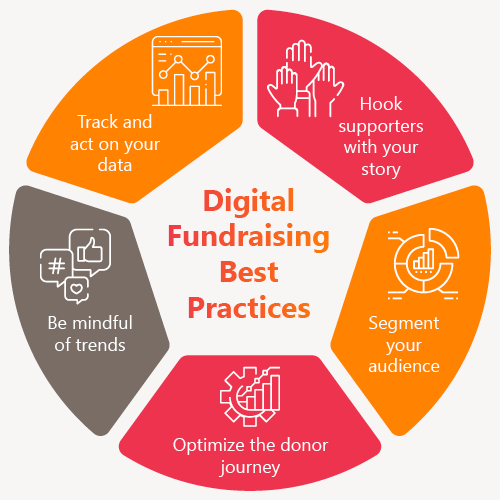
Hook supporters with your organization’s story
No matter the platform—whether online, in person, or in print—your organization’s story should drive your fundraising campaigns.
It’s more important than ever that your organization develops a unique story that sets it apart from similar groups. Plus, Younger Millennial and Gen Z donors want to have an active role in pushing forward the social causes that matter to them, so bring supporters into your story. Highlight what they will be able to accomplish through their support, not what your organization can get done with their help.
Your story should:
- Follow a clear structure. Whether you tell it using your social media pages, email newsletter, or website, your story should have a clear structure. It’s helpful to follow the three-act story structure. First, set the scene and introduce the protagonist. For a nonprofit story, this person could be a beneficiary, volunteer, board member, or donor. Then, describe the challenges that the main character faces, and how they overcome those challenges. You can also talk about how your organization supported the main character throughout the process. This type of structure helps you create a straightforward, compelling story that gives potential donors everything they need to know to make an informed decision about whether to donate.
- Be personalized to the audience. Use tools such as your donor management software to keep track of supporters’ preferences, such as their preferred communication platform or most frequented event. Then, personalize your storytelling style to appeal to each supporter. For example, you might have some supporters who prefer reading your stories in your monthly email, while others would appreciate a one-on-one phone call. Tailored storytelling will be much more engaging for supporters than a generic, one-size-fits-all approach.
- Highlight donors’ impact. The best stories bring donors into the narrative by highlighting what they accomplished, not what your organization accomplished. For example, avoid saying things like “Because of our nonprofit, 45 shelter dogs were rescued from local community streets.” Instead, place donors at the center of the story by saying “Because of the support of generous donors like you, 45 shelter dogs will have a warm, safe place to sleep tonight.”
Development communications studies have shown that the brain responds positively to stories that showcase impact, or how donations make a difference in the lives of real people. Essentially, donors want to know that their gifts are going directly toward those who need them the most, and storytelling can help show donors how impactful their support really is.
Segment your audience
To develop a compelling digital fundraising approach, you have to know your audience and speak to them in ways that resonate with their unique interests.
But your audience is probably made up of people with unique needs and motivations. How can you create a personalized experience for them without spending hours upon hours creating individualized messages for every donor?
The answer lies in audience segmentation. The segmentation process looks like this:
- Review your supporter database to identify trends and patterns among your donors.
- Filter your donor list based on characteristics such as demographics, donation type, donation frequency, and other traits.
- Create segments by grouping donors who share these characteristics.
- Capture supporters’ attention by sending each segment more personalized marketing content that appeals to their unique interests.
By creating messages for each audience segment, rather than each individual audience member, your marketing and fundraising teams will save precious time.
Understand and optimize the donor journey
The donor journey refers to the steps your supporters take to learn more about your organization and determine whether they want to financially support you. One of the final stages of the donor journey is when donors access your donation page and make a gift.
According to the M+R Benchmarks study, the average conversion rate for website donation pages was only 17% in 2021. You can calculate your organization’s conversion rate by dividing the number of donors who gave using your online donation page by the total number of donation page visits. Multiply that number 100 to get your conversion rate percentage. For example, if 500 people visit your donation page in a given period and 100 of those people give, your conversion rate would be 20%.
To facilitate a smoother donor journey and boost your donation page conversion rate, make it easy for supporters to find and fill out your online donation form. Use call-to-action (CTA) buttons throughout your website, email, and social media pages to drive traffic to your donation page.
Then, follow these tips to create a streamlined and accessible donation page:
- Ensure the page is mobile-friendly. In 2021, approximately 28% of online donations were made using mobile devices. A mobile-friendly online donation form gives mobile users an equally positive experience as desktop or tablet users, increasing mobile conversions.
- Only ask for necessary information. This includes donor names, contact information, and payment details. Keeping the form short and simple to fill out makes donors more likely to complete the full page.
- Offer suggested donation amounts. Make it easy for donors to choose their gift amount by offering suggested donation amounts based on your organization’s average gift size. For example, if your average gift size is $50, you might offer suggested donations of $30, $50, and $70.
- Promote recurring gifts. Recurring giving options, like a monthly giving program, make it easy for donors to show their long-term support for your cause. Offer a button for donors to turn their one-time gift into a recurring monthly contribution.
- Highlight matching gift opportunities. In corporate matching gift programs, businesses match donations made by their employees. Plenty of donors don’t even know these programs exist, let alone whether they are eligible or not. Embed a matching gift database into your online donation form to allow donors to quickly research their matching gift eligibility and access the forms they need to fill out to apply for a match.
An easily accessible, streamlined giving page can make all the difference in converting website visitors and other online audiences to donors.
Track and act on your data
All of your digital fundraising campaigns will provide valuable data insights that you can use to assess progress and adapt future strategies as needed.
Make sure that you track and regularly report on data such as:
- Social media engagement metrics, such as reach and follower growth over time
- Email open and clickthrough rates
- Website bounce rate, time on page, and conversion rate
- Donation page conversion rate
- Online fundraising total
- Donor demographics
- Online donor retention rate
Your reports should show data comparisons and change over time. Identify any positive and negative data trends to determine which areas of your digital fundraising strategy require adjustments.
Examples of Successful Online Fundraising Campaigns
Looking for inspiration ahead of your next digital campaign? Explore these effective online fundraising examples for ideas:
Non-GMO Project: Digital Lead Generation Campaign

Non-GMO Project, a nonprofit dedicated to preserving and expanding access to non-GMO foods, was experiencing unprecedented social media success. The organization built a powerful online audience with over one million followers on Facebook and other social platforms. However, they wanted to create a clearer pathway to transform social media followers into donors.
Enter BWF. We partnered with Non-GMO Project to help launch their first-ever digital lead generation campaign. The organization launched an Earth Day campaign targeting Facebook followers with a customized landing page. After gathering leads, Non-GMO Project followed up using personalized email content.
Ultimately, the campaign generated 3,000 new leads for the nonprofit and led to three additional campaigns in the same year that all helped to build fundraising capacity and diversify revenue.
The Movember Foundation: Movember
Movember is an annual event held in November that encourages supporters to grow mustaches to raise awareness and funds for men’s health. Participants create a profile page with their fundraising goals and information about ways to support men’s health. Then, they share the page with family members and friends to gather donations.
These campaigns are so successful because they allow supporters to take control and spread awareness about the organization’s mission to a wider audience. As a result, Movember 2023 saw the creation of 316,000 peer-to-peer fundraisers to support the cause.
77% of people say that recommendations from family members and friends are the most persuasive form of new product information. This underscores the power of peer-to-peer fundraising and its ability to drive new support through trusted recommendations.
Plus, Movember is proactive about explaining what donations go toward, whether that’s prostate cancer research or mental health support. Providing clear information about how donations are used gives supporters more trust in these campaigns.
Nature Conservancy: Plant a Billion Trees
Plant a Billion Trees is a Nature Conservancy digital campaign to help restore and protect forests worldwide. The campaign calls for donations to cover tree-planting costs and offers additional ways to get involved, such as through volunteering or cause marketing.
The campaign uses videos, FAQs, and interactive maps to illustrate the extent of the project and ensure potential donors have all the information they need to make an informed giving decision. Donors can even gift a tree to a friend or family member to celebrate a holiday, birthday, or another special occasion.
The interactive nature of this digital campaign helps supporters feel like true partners in achieving the mission to plant one billion trees.
American Cancer Society: Virtual Challenges
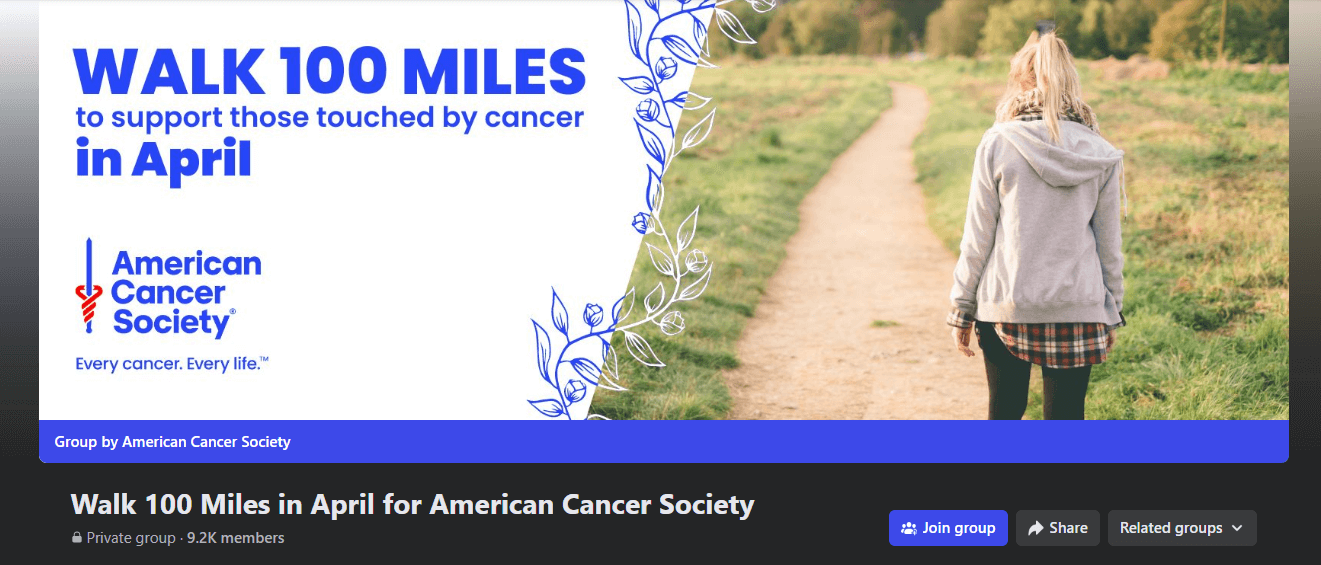
The American Cancer Society offers a variety of ongoing virtual Facebook challenges for supporters to choose from based on their preferences. Examples include a jump-roping challenge or cycling 100 miles in a month.
Participants create a Facebook fundraiser and join a private Facebook group where they can discuss the challenge and share fundraising updates and advice. Receiving motivation and support from fellow fundraisers helps participants feel like part of something bigger than themselves, fostering a strong sense of community.
In Summary
A powerful digital fundraising strategy requires careful planning, goal-setting, and a variety of campaign ideas to engage your supporters. By building your strategy using these best practices and engaging campaign ideas, you’ll be well on your way to growing your digital fundraising efforts sustainably for the long term.
If your organization could benefit from the expertise of an impartial, third-party organization, don’t hesitate to reach out to the BWF team. We offer strategic campaign planning, donor engagement strategizing, and other digital strategic planning solutions to help organizations raise more and better engage with their audiences.
Looking for more information about digital fundraising? Start with these additional resources:
- Donor Experience: How to Create Unforgettable Moments. Creating a positive donor experience is essential to boosting retention. Use these strategies to plan memorable supporter interactions.
- Looking for CRM Consulting? Here’s What You Need to Know. Effective digital fundraising requires using the right software solutions, including your nonprofit CRM. This guide explains what to look for when hiring a CRM consultant.
- AI for Nonprofits: How to Leverage Machine Learning for Good. Looking to incorporate AI solutions into your digital fundraising strategy? BWF’s complete guide offers everything you need to know about how to use these tools responsibly and productively.
Let’s Talk
Find out how BWF can partner with you to launch your digital fundraising strategy.



